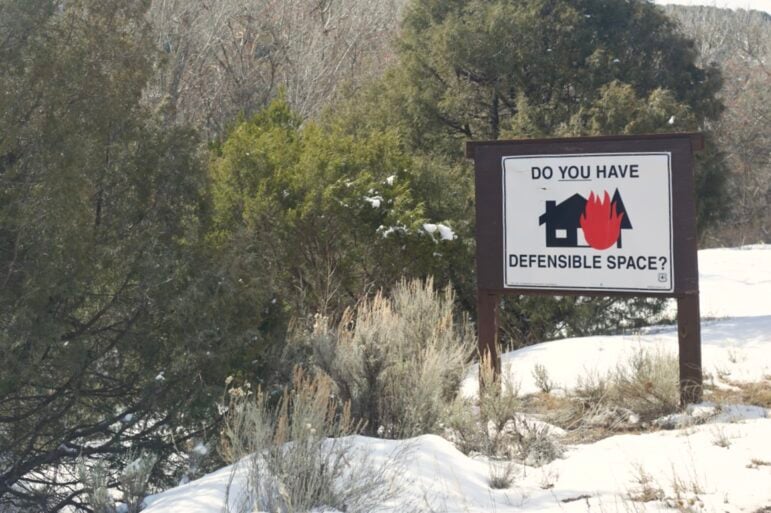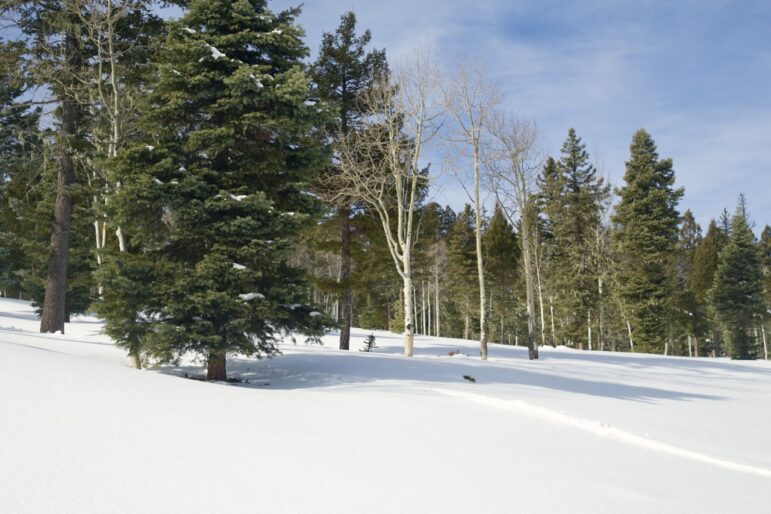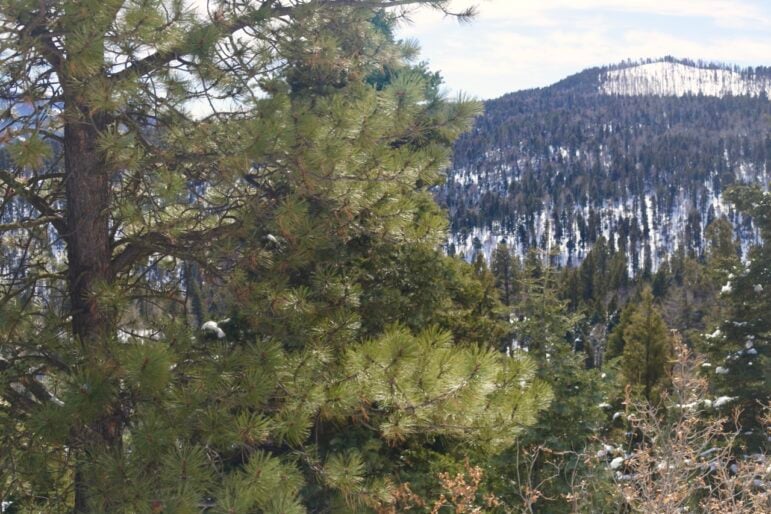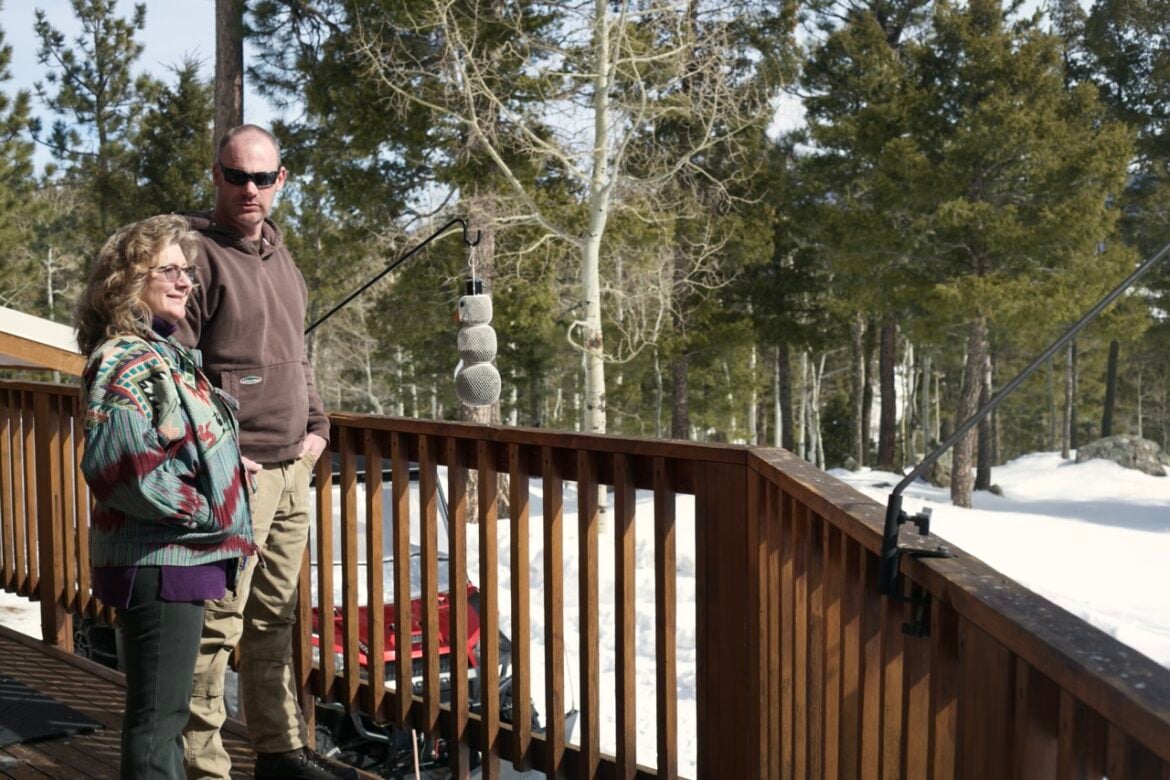Kim Wright has spent hundreds of hours on the phone with neighbors.
Wright, a retired nurse, volunteers with the Cimarron Watershed Alliance, a nonprofit focused on watershed and forest health on the eastern edge of the Sangre de Cristo Mountains. The 2022 Hermits Peak-Calf Canyon fire made the fears of a catastrophic fire feel all the more real. So when she learned a year ago that the federal government was awarding more than $8 million to the alliance to help nine northern New Mexico communities better defend themselves against wildfire, she said, “We couldn’t believe it. We were so excited.”
Creating defensible space around a house and structures, thinning nearby forests, and hauling away wood can cost up to $4,000, Wright said, “So this is a huge opportunity for everybody in these communities.”
But people needed to know about the opportunity. She found and reserved places for three community meetings that later drew between 40 and 90 attendees each. She and her husband made coffee and served snacks. She individually followed up with attendees who owned property in the area and mailed hundreds of hand-addressed envelopes. She responded to every email she received.
A year later, those communities are still awaiting signs of on-the-ground wildfire preparedness as fire season fast approaches
The money awarded to the Cimarron Watershed Alliance was part of nearly $11.5 million in federal funding local governments and nonprofits secured for wildfire preparedness in New Mexico, including work to protect homes and plan for wildfires, through the newly established Community Wildfire Defense Grants program.
The Forest Service announced the awards a year ago, and some nonprofits began staffing up, planning to get to work last summer. But a mismatch in federal and state paperwork stalled distribution of that money for months. The bigger lesson speaks to problems arising throughout the country with some of the Biden administration’s landmark legislation: Status quo state and federal systems are struggling to distribute money available in this era of once-in-a-lifetime funding opportunities.
Wildfire season has worsened over the past decade and a half, especially in the West. New Mexico’s two largest wildfires in the state’s history happened in 2022, burning more than 600,000 acres and resulting in hundreds of lost homes. The next three largest were recorded in the early 2010s.

Historic forest management practices, wildfire suppression, and climate change have made wildland fires increasingly extreme over recent decades. These days, wildfire season sprawls throughout the year, and fires are putting a growing number of homes, people, landscapes and watersheds at risk.
“The wildfire crisis in the United States is urgent, severe, and far reaching” begins a 340-page report presented to Congress last September by a newly created 50-member Wildland Fire Mitigation and Management Commission. The commission made nearly 150 recommendations in that report, including calling for more collaborative and proactive approaches to respond to this crisis — like those prioritized in the Community Wildfire Defense Grants program.
In 2021, Congress appropriated $1 billion over five years in the massive Bipartisan Infrastructure Act for the program.
“Ultimately, the investments will help communities, especially those that need resources, to achieve fire mitigation efforts that could save property and infrastructure but, more importantly, lives,” a public affairs specialist with the U.S. Forest Service Southwest Region wrote in an email.
Communities can apply for up to $10 million to implement projects. That level of funding allows for an unparalleled increase in pace and scale. A low and waivable cost share also makes this money available to underserved and lower-income communities. The nearly $11.5 million New Mexico was awarded was a share of nearly $200 million distributed during the program’s first year.
The program is “game-changing,” said Laura McCarthy, New Mexico’s state forester, who has worked on wildfire policy for two decades. “It is based on a lot of science and it’s also bringing a scale of resources that we’ve never seen before in this arena.”
As a new program, it took time to ramp up capacity both at the federal and state level, say staff at the U.S. Forest Service and New Mexico’s Energy, Minerals and Natural Resources Department. The Forest Service said it made the funds available to the state of New Mexico in August. But it was November before New Mexico’s awardees began receiving paperwork to access that money, and more months before dollars started flowing.
The program’s setup was problematic from the start: State lawmakers had to pass an exemption to the state’s procurement code during last year’s legislative session just to allow the state to funnel money from the U.S. Department of Agriculture, which oversees the U.S. Forest Service, to grantees. But the state also requires certain information, terms and conditions in contracts, and those details weren’t mirrored in the federal grant application documents.
“It’s taken us a while,” McCarthy said. New Mexico “opted in” to help administer the program, but states could also choose to “opt out” and allow the federal agency to work directly with grant recipients. “Maybe we would opt out,” she added, “now that we know what it really means.”

The delays have reached beyond the nine northern New Mexico communities Wright worked to inform.
The nonprofit Forest Stewards Guild, which promotes responsible forestry around the nation, won a $1.3 million grant to assess wildfire hazards around homes, reduce nearby fuels likely to spread sparks into structures, and increase outreach around Santa Fe, where it is headquartered. The nonprofit hired a new staff member last summer, but that person was put on other tasks while waiting for the grant funding to materialize. They finally started on their project in January, said Eytan Krasilovsky, deputy director of the Forest Stewards Guild, “But it means we missed a season of doing something.”
“People are talking about ‘the crisis,’ and this doesn’t feel like they’re treating it like a crisis,” he added.
Colorado, unlike New Mexico, chose to let the federal government administer the program. A Colorado county where the Guild also collaborates on projects had grant money flowing and work underway last summer.
“The Forest Service is getting tons of funding, but they can’t move it quickly and efficiently, or their state partners can’t move it quickly or efficiently,” Krasilovsky said, and given the urgency, “These things just have to be better.”
In Sandoval County, as firefighters evacuated a rural community and popular campgrounds and recreational areas during the 2022 Cerro Pelado Wildfire, county staff saw yet another reminder that its Community Wildfire Protection Plan needed updating. That document guides efforts to prevent and respond to wildfires.
“It was just another indicator that we really had to update this plan and identify, what are the hazards, where are our evacuation zones, what are we needing to do, first of all, to help prevent a fire,” said Eric Masterson, Sandoval County fire chief.
Sandoval County received a Community Wildfire Defense Grant to update the plan, but delayed funding means it won’t be in place before this wildfire season. It also narrows the window for completing a robust, community input-driven plan before the coming rounds of the Community Wildfire Defense Grant applications. Last fall, 12 more New Mexico communities applied for grants to update such plans.
“It’s a fine line — we want to make sure we’ve done it well, and don’t miss something, and we want to have it done so that when other opportunities come up … things are in place for people to move forward,” Masterson said.
The largest of New Mexico’s grants from 2023—two grants totaling $9.8 million—went to the Cimarron Watershed Alliance, the organization for which Wright volunteers. That money will be spent creating defensible space around hundreds of homes and widening a fuel break to give firefighters a foothold for slowing wildfire. The Cimarron Watershed covers 670,000 acres of forest and grasslands in Colfax County, and about a quarter of the county has been blackened by severe wildfire, said Rick Smith, the allliance’s executive director and a volunteer firefighter. The wildfire defense grant will be spent trying to protect what’s left.

“It’s a race against time,” he said.
After news of the grant came last year, Smith hired three people, bringing the organization’s total to four employees. Staff started planning projects and walking properties with landowners, racking up $25,000 in time and mileage.
“We’re having to implement all of this through the bootstrap kind of method,” Smith said, “so the financials are definitely a strain on us.”
Both grant contracts finally arrived in November after months of work by alliance staff, but the state says it can’t reimburse those costs because they are “pre-award costs.”
“They didn’t have to staff up. That was their decision,” McCarthy said. “It’s frustrating—but it doesn’t help them or us if we give them the money illegally.”
However, the Forest Service public information office said reimbursing pre-award expenses for salaries and travel is allowed and the award paperwork says as much.
As for Wright, she’s still on the phone. Now, she’s fielding questions about when, exactly, work people were so excited to sign up for will commence.
“They call me and say, ‘Have you heard anything?’” Wright said. “I always say, ‘Call me anytime. And try not to get frustrated. These things aren’t quick.’”
